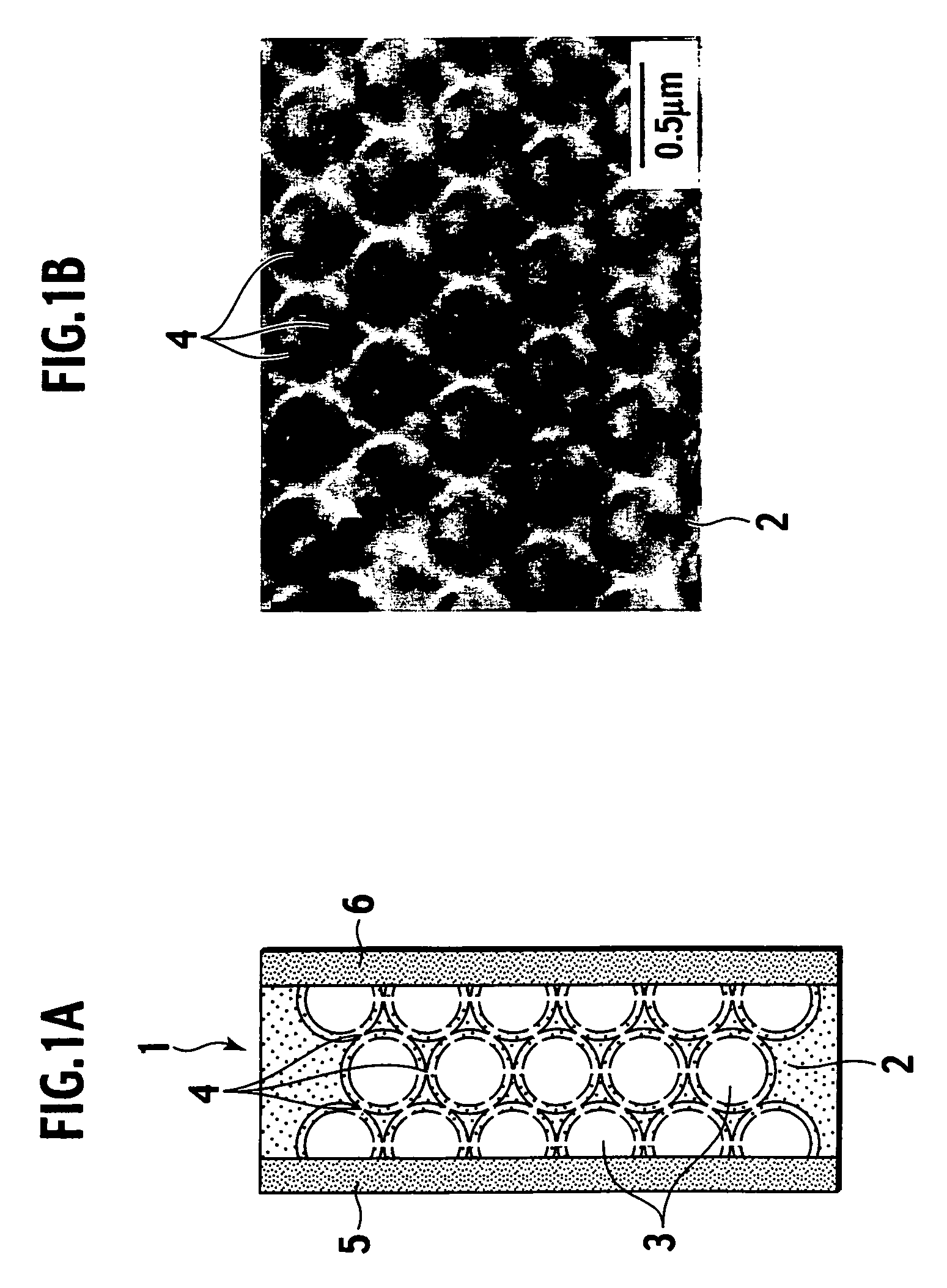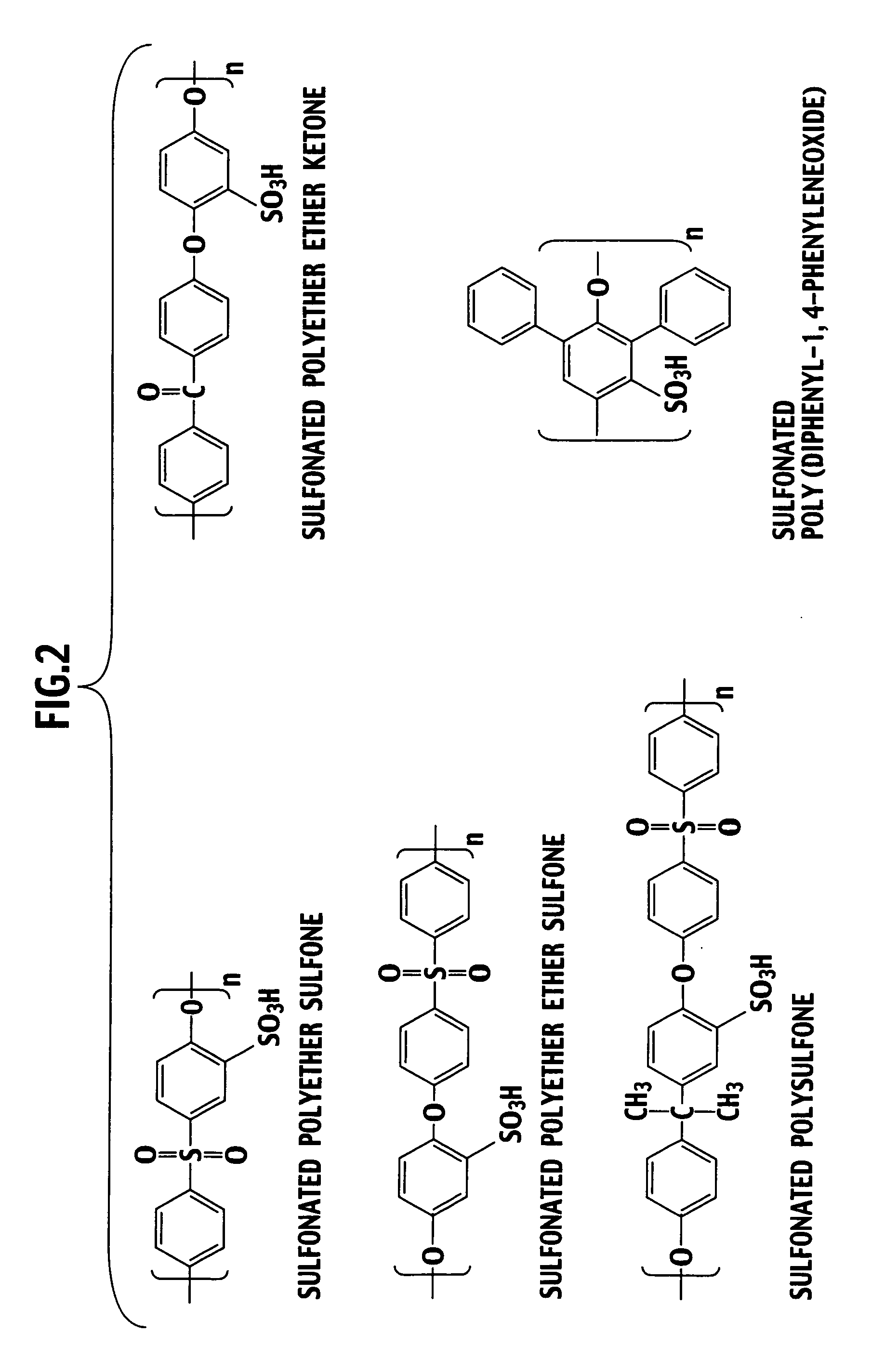Proton-conductive composite electrolyte membrane and producing method thereof
a proton-conductive, composite electrolyte technology, applied in the direction of cell components, final product manufacturing, sustainable manufacturing/processing, etc., can solve the problems of high possibility of electrode breakage, material concerned cannot be applied to a system, electrode breakage, etc., to achieve excellent ion conductivity, reduce swelling, and high heat resistance
- Summary
- Abstract
- Description
- Claims
- Application Information
AI Technical Summary
Benefits of technology
Problems solved by technology
Method used
Image
Examples
first embodiment
[0037]A composite electrolyte membrane of the present invention is composed by arranging a hydrocarbon electrolyte material into plural spherical pores owned by a porous body composed of an inorganic material.
[0038]Specifically, as shown in FIG. 1A and FIG. 1B, a porous body 2 constituting an electrolyte membrane 1 of the present invention is composed of an inorganic material, and includes plural spherical pores 3 therein. Moreover, the spherical pores 3 have a substantially equal diameter, and exist three-dimensionally in the porous body 2. Furthermore, the spherical pores 3 adjacent to each other communicate with each other by a communicating port 4. An electrolyte material performing proton conduction is filled in the spherical pores 3 and the communicating ports 4. In constituting a polymer electrolyte fuel cell, an anode 5 and a cathode 6 are arranged on side faces of the electrolyte membrane 1 of the present invention.
[0039]As described above, the porous body 2 composed of the...
example 1
[0066]A silica porous membrane was used as a matrix, the proton-conductive polymer was introduced into pores thereof, and the inorganic / organic composite electrolyte membrane was thus fabricated.
[0067]1) Fabrication of Inorganic Porous Body
[0068]As the organic resin material for controlling the pore diameter of the inorganic porous body, polystyrene spherical particles with a mean diameter of approximately 500 nm was used. The polystyrene spherical particles and colloidal silica with a diameter of 70 to 100 nm were mixed and prepared so that the porous body could have a predetermined film thickness when being formed with regard to a volume of a solute contained in the suspension. As for the procedure, first, a predetermined amount of polystyrene was weighed, and added to water. Thereafter, a solution containing the colloidal silica was added to a liquid containing the polystyrene particles. Then, ultrasonic agitation was performed for the liquid thus obtained, and the suspension in ...
second embodiment
[0082]Description is made below of a proton-conductive composite electrolyte membrane of a second embodiment. The same reference numerals are assigned to constituents described in the following specification with reference to the drawings, which have the same functions as those described in the first embodiment, and duplicate description thereof is omitted.
[0083]In the proton-conductive composite electrolyte membrane of this embodiment, a proton-conductive functional group is provided on an interface between the inorganic porous body and the hydrocarbon electrolyte in the composite electrolyte membrane of the first embodiment. Specifically, as shown in FIG. 7, an inorganic porous body 2 constituting a composite electrolyte membrane 10 includes the plural spherical pores 3 as described above; however, in this embodiment, a proton-conductive functional group 7 is provided on the surfaces of the spherical pores 3. Since the hydrocarbon electrolyte is filled in the spherical pores 3, th...
PUM
| Property | Measurement | Unit |
|---|---|---|
| diameter | aaaaa | aaaaa |
| ion-exchange capacity | aaaaa | aaaaa |
| diameter | aaaaa | aaaaa |
Abstract
Description
Claims
Application Information
 Login to View More
Login to View More - R&D
- Intellectual Property
- Life Sciences
- Materials
- Tech Scout
- Unparalleled Data Quality
- Higher Quality Content
- 60% Fewer Hallucinations
Browse by: Latest US Patents, China's latest patents, Technical Efficacy Thesaurus, Application Domain, Technology Topic, Popular Technical Reports.
© 2025 PatSnap. All rights reserved.Legal|Privacy policy|Modern Slavery Act Transparency Statement|Sitemap|About US| Contact US: help@patsnap.com



